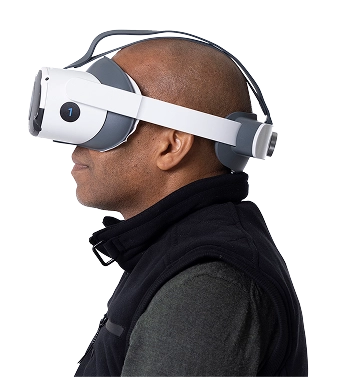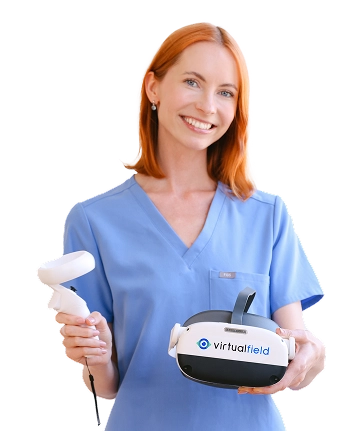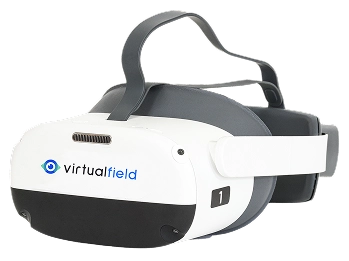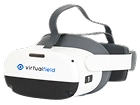The time it takes a patient’s eyes to adjust from bright light to darkness is a critical part of retinal function assessment. The dark adaptation test, performed using a dark adaptation test device, measures how efficiently the retina recovers sensitivity after exposure to light. This makes it a powerful early AMD detection tool, especially in patients at risk of age-related macular degeneration. You can also use this test to identify conditions that affect photoreceptor function, like vitamin A deficiency, and inherited retinal dystrophies.
Currently, this test is not available on Virtual Field. However, it can be worthwhile to add dark adaptation to your comprehensive eye exam routine, especially for patients at risk of age-related macular degeneration.
How the Dark Adaptation Test Device Works for Retinal Function Assessment
Humans aren’t known for having excellent night vision compared to other animals, but they do adjust to darkness faster than many species.
When transitioning from light to dark, the human eye must shift from using cone photoreceptors (responsible for daylight and color vision) to rods, which are far more sensitive to dim light. In healthy adults, it can take up to 30 minutes for the rod function to return fully. A dark adaptation test device captures this recovery curve digitally, providing an objective, time-based retinal function assessment.
Dark adaptation testing quantifies this process, usually after a light bleach that intentionally saturates the retina. As rods regain sensitivity, you can track how long it takes the patient to detect increasingly dim stimuli. The most important outcome is the rod intercept time, a valuable marker for early AMD detection and photoreceptor performance.
Academic references and clinical validation
There is a known link between age-related macular degeneration (AMD) and poor night vision, and measuring dark adaptation can help lead to earlier diagnoses.
Rapid dark adaptometry tests and mobile apps are shown to be useful, especially in detecting AMD. The sensitivity of these tests is promising, which could help overcome the time-consuming nature of the test.
Our customers realize an average of 902% return on investment with Virtual Field.
.avif)

30 days free.
No strings attached.
We are confident you’ll love Virtual Field just like the 2,000 doctors who have already made the switch.
What to Expect from a Dark Adaptation Test Device Exam
Dark adaptometry is typically performed monocularly in a darkened environment. The test begins with an initial light bleach phase that desensitizes photoreceptors in the central vision. During the recovery phase, the patient fixates on a dim red target while responding to a series of stimuli, while a technician plots the recovery curve in real time. This process takes between 10 and 30 minutes, depending on the protocol.
Using a dark adaptation test device, clinics can reduce variability and improve data accuracy during this longer diagnostic process. It’s a valuable test that can be revealing for patients with AMD, but this long duration can create workflow challenges.
Pros and cons of Visual Contrast Sensitivity Testing
The pros and cons that follow can help guide you toward the ideal scenarios to incorporate this test into your patients' diagnostic assessments.
Pros
This exam provides early, sensitive insights into retinal dysfunction, especially when performed with a dark adaptation test device.
A reliable retinal function assessment that can be repeated over time to evaluate disease progression.
Dark adaptometry helps stage retinal disease and evaluate treatment response.
Cons
This test is unquestionably time-consuming.
Patient cooperation is a must, which can be challenging or even frightening for elderly, anxious, or cognitively impaired patients.
Dark adaptation testing requires specialized equipment that may or may not be readily available.
Conditions Identified by Dark Adaptation Testing for Early AMD Detection
These conditions affect rod function and dark adaptation, making the test a valuable early AMD detection tool and a broader method for retinal function assessment.
Age-Related Macular Degeneration
Delayed dark adaptation is one of the earliest functional changes in AMD, even before abnormalities appear on imaging. A prolonged rod intercept time is a hallmark of early or intermediate AMD, even before visual acuity changes.
Retinitis Pigmentosa (RP)
In inherited rod-cone dystrophies, rods degenerate early, leading to severely delayed or absent dark adaptation. This test helps track progression and phenotyping. Testing with a dark adaptation test device ensures objective tracking of disease progression over time.

~ 1 in 3,500
About 1 in 3,500 to 1 in 4,000 people are affected by RP
100+
100+ genes are known to cause RP.
Vitamin A Deficiency
Because vitamin A is essential for the regeneration of rhodopsin (the visual pigment in rods), deficiency can result in night blindness and a severely impaired dark adaptation curve. This condition is reversible with supplements.
Ocular Trauma and Surgical Recovery
After retinal detachment repair or laser treatments, rod function may be disrupted. Dark adaptation tests can track the return of low-light vision.
Dark Adaptation Curve: A Visual Retinal Function Assessment Example
Source: Fluorescence Media
30 days free.
No strings attached.
We are confident you’ll love Virtual Field just like the 2,000 doctors who have already made the switch.

CPT Code, Billing and Reimbursement for Dark Adaptation Test Device Exams
CPT code 92284 is used specifically for dark adaptation eye exams using a dark adaptation test device. Under the CMS fee schedule, reimbursement varies based on location and care setting. According to the CMS fee schedule, this code is billable between $26 and $40, but this will vary depending on your practice’s location, type, and setting.
When is the dark adaptation test required?
Most often, this test is used to diagnose or measure the progress of age-related macular degeneration. At-risk and early-stage AMD patients should have their dark adaptation measured to help establish a management plan. Patients who complain of poor night vision, squinting, or trouble finding things in low light may also benefit from this test.
Is dark adaptometry required for driver’s licenses?
No states require dark adaptation measurements for driver’s licenses, but it may be helpful for certain occupations, such as air traffic controllers or military defense personnel. Consider offering it to patients who are concerned about their ability to drive at night.
Complete Your Comprehensive Vision Exams with Virtual Field
While not yet supported by Virtual Field, this early AMD detection tool can play a crucial role in improving visual outcomes and patient quality of life. Dark adaptation testing provides insight into how well the retina functions in low light, something conventional imaging can’t show. It’s not routinely used in every setting, but it can provide insight into early-stage retinal conditions or post-surgical recovery. For many patients, it can be a key component of improved outcomes at successful, thriving eye care practices.
Want all 23 exam guides in one place?
Download our comprehensive guide for 160+ pages of insights.
FAQs
1. What rod-intercept time indicates early AMD on a dark adaptation test?
2. How is a dark adaptation exam billed?
3. Do cataracts affect dark-adaptation results?
4. How soon should I repeat testing after starting AREDS2 supplements?
5. Why doesn't Virtual Field offer a Dark Adaptation test?
Ready to get started?
Schedule a demo or begin your 30-day free trial of Virtual Field to try our EOM exam in your practice.

Questions? Contact sales@virtualfield.io talk to a Virtual Field expert today.



